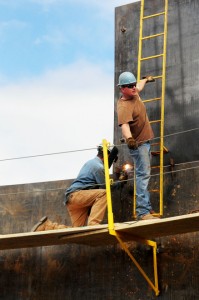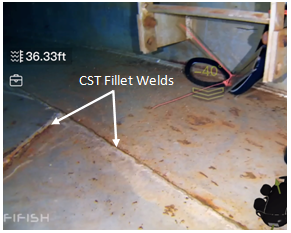The Crucial Duty of Storage Tank Welding Assessment in Ensuring Structural Stability and Safety Conformity in Industrial Applications
In the world of industrial applications, tank welding evaluation arises as a crucial element in securing architectural integrity and guaranteeing conformity with safety and security regulations. Utilizing a combination of methods such as aesthetic assessments and advanced testing techniques, these assessments offer to recognize and mitigate potential defects before they intensify right into considerable dangers.
Relevance of Tank Welding Evaluation

Ensuring conformity with market requirements and laws is one more significant aspect of container welding assessment. Regulative bodies mandate stringent guidelines for the building and construction and upkeep of storage tanks, and thorough assessments help companies adhere to these requirements. Non-compliance can cause serious penalties, including penalties and shutdowns, further stressing the requirement for rigorous inspection methods.
Furthermore, tank welding examination plays a vital role in keeping operational efficiency. Normal assessments can recognize potential concerns before they escalate, assisting in timely fixings and reducing downtime. This proactive technique not only improves safety however likewise adds to cost financial savings in the long run. In recap, the importance of tank welding inspection depends on its capacity to safeguard public health and wellness, shield the atmosphere, and guarantee compliance with governing structures.
Key Assessment Strategies
Reliable container welding examination relies on a variety of essential methods that guarantee complete analysis of weld top quality and architectural honesty. Among one of the most prevalent techniques are visual examination, ultrasonic testing, radiographic testing, and magnetic bit screening - Tank Welding Inspection. Each technique provides unique advantages in analyzing various aspects of the weld
Visual evaluation functions as the first line of defense, permitting assessors to determine surface problems, irregularities, or inconsistencies in the weld grain. Ultrasonic screening utilizes high-frequency acoustic waves to spot internal imperfections, such as splits or spaces, offering a comprehensive analysis of weld stability. This approach is especially effective in detecting concerns that may not show up on the surface area.
Radiographic screening utilizes X-rays or gamma rays to generate pictures of the welds, revealing inner stoppages and supplying a long-term record for future recommendation. This technique is highly reliable for vital applications where the risk of failure must be reduced.
Finally, magnetic particle testing is used to identify surface area and near-surface problems in ferromagnetic products. By applying electromagnetic fields and fine iron fragments, inspectors can determine gaps that could jeopardize the architectural stability of the more info here container. Together, these methods form a robust structure for guaranteeing high-grade welds in industrial applications.
Conformity With Safety Requirements

Regular assessments play a critical duty in making sure compliance by determining potential failings or deviations from suggested standards. Assessors are trained to examine weld quality, confirm material specs, and assess the general architectural integrity of containers. Their know-how is vital in making sure that welding processes satisfy the called for safety requirements.
In addition, compliance with safety and security requirements not just shields employees however likewise safeguards the setting from potential dangers such as leakages or disastrous failings. Organizations that prioritize safety and security conformity are better placed to mitigate threats, boost operational efficiency, and cultivate a society of security within their workforce. In summary, maintaining extensive conformity with safety and security requirements is indispensable for the successful operation of container welding activities in commercial settings.
Benefits of Routine Evaluations
Routine examinations are integral to preserving the structural honesty and security of bonded storage tanks. These evaluations offer a methodical method to recognizing prospective issues or weak points in the welds, guaranteeing that any type of problems are addressed before they intensify right into considerable failings. By performing routine evaluations, companies can identify rust, tiredness, and various other kinds of deterioration that may jeopardize container performance.
Additionally, consistent evaluations contribute to conformity with sector policies and criteria. Adhering to these standards not only reduces legal dangers but also improves the organization's online reputation for safety and dependability. right here Regular inspections promote a positive official source security culture, urging staff members to identify and focus on the value of tools stability.

Case Studies and Real-World Applications
Situation studies and real-world applications illustrate the concrete influence of effective storage tank welding assessment practices. Complying with the application of strenuous welding assessment protocols, including visual and ultrasonic screening, the center recognized important defects in weld joints that might have led to devastating failures.
Likewise, a water treatment plant implemented a detailed examination program for its tank welding operations - Tank Welding Inspection. By including non-destructive testing methods, the plant had the ability to detect very early indicators of deterioration and fatigue in weld joints. This timely treatment extended the life expectancy of the tanks and guaranteed compliance with safety and security guidelines, thus safeguarding public health and wellness
These case studies emphasize the importance of regular and methodical tank welding examinations. By prioritizing these practices, industries can minimize dangers, enhance architectural honesty, and guarantee compliance with safety and security requirements, eventually leading to improved operational efficiency and minimized responsibilities.

Final Thought
In conclusion, tank welding evaluation is an indispensable component of maintaining architectural stability and security in commercial applications. Utilizing numerous assessment techniques makes certain early discovery of potential problems, therefore protecting against disastrous failings. Adherence to safety and security requirements even more improves operational integrity and conformity with governing requirements. Ultimately, regular assessments not just safeguard public health and wellness and the atmosphere however likewise add to the durability and effectiveness of crucial assets, emphasizing the crucial duty of this technique in commercial procedures.